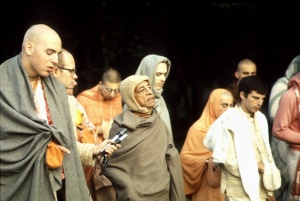CC Adi 7.11 (1975): Difference between revisions
(Vanibot #0027: CCMirror - Mirror CC's 1996 edition to form a basis for 1975) |
(Vanibot #0020: VersionCompareLinker - added a link to the Version Compare feature) |
||
| Line 2: | Line 2: | ||
<div style="float:left">'''[[Sri Caitanya-caritamrta (1975)|Śrī Caitanya-caritāmṛta (1975)]] - [[CC Adi (1975)|Ādi-līlā]] - [[CC Adi 7 (1975)|Chapter 7: Lord Caitanya in Five Features]]'''</div> | <div style="float:left">'''[[Sri Caitanya-caritamrta (1975)|Śrī Caitanya-caritāmṛta (1975)]] - [[CC Adi (1975)|Ādi-līlā]] - [[CC Adi 7 (1975)|Chapter 7: Lord Caitanya in Five Features]]'''</div> | ||
<div style="float:right">[[File:Go-previous.png|link=CC Adi 7.10 (1975)|Ādi-līlā 7.10]] '''[[CC Adi 7.10 (1975)|Ādi-līlā 7.10]] - [[CC Adi 7.12 (1975)|Ādi-līlā 7.12]]''' [[File:Go-next.png|link=CC Adi 7.12 (1975)|Ādi-līlā 7.12]]</div> | <div style="float:right">[[File:Go-previous.png|link=CC Adi 7.10 (1975)|Ādi-līlā 7.10]] '''[[CC Adi 7.10 (1975)|Ādi-līlā 7.10]] - [[CC Adi 7.12 (1975)|Ādi-līlā 7.12]]''' [[File:Go-next.png|link=CC Adi 7.12 (1975)|Ādi-līlā 7.12]]</div> | ||
{{CompareVersions|CC|Adi 7.11|CC 1975|CC 1996}} | |||
{{RandomImage}} | {{RandomImage}} | ||
==== TEXT 11 ==== | ==== TEXT 11 ==== | ||
| Line 32: | Line 31: | ||
<div class="purport"> | <div class="purport"> | ||
Although Kṛṣṇa is the reservoir of all pleasure, He has a special intention to taste Himself by accepting the form of a devotee. It is to be concluded that although Lord Caitanya is present in the form of a devotee, He is Kṛṣṇa Himself. Therefore Vaiṣṇavas sing, śrī-kṛṣṇa-caitanya rādhā-kṛṣṇa nahe anya: | Although Kṛṣṇa is the reservoir of all pleasure, He has a special intention to taste Himself by accepting the form of a devotee. It is to be concluded that although Lord Caitanya is present in the form of a devotee, He is Kṛṣṇa Himself. Therefore Vaiṣṇavas sing, śrī-kṛṣṇa-caitanya rādhā-kṛṣṇa nahe anya: Rādhā and Kṛṣṇa combined together are Śrī Kṛṣṇa Caitanya Mahāprabhu. Caitanyākhyaṁ prakaṭam adhunā tad-dvayaṁ caikyam āptam. Śrī Svarūpa-dāmodara Gosvāmī has said that Rādhā and Kṛṣṇa assumed oneness in the form of Śrī Caitanya Mahāprabhu. | ||
</div> | </div> | ||
Latest revision as of 19:14, 26 January 2020

A.C. Bhaktivedanta Swami Prabhupada
TEXT 11
- kṛṣṇa-mādhuryera eka adbhuta svabhāva
- āpanā āsvādite kṛṣṇa kare bhakta-bhāva
SYNONYMS
kṛṣṇa-mādhuryera—the supreme pleasure potency of Kṛṣṇa; eka—is one; adbhuta—wonderful; svabhāva—nature; āpanā—Himself; āsvādite—to taste; kṛṣṇa—the Supreme Personality of Godhead; kare—does; bhakta-bhāva—accept the form of a devotee.
TRANSLATION
The transcendental mellow of conjugal love of Kṛṣṇa is so wonderful that Kṛṣṇa Himself accepts the form of a devotee to relish and taste it fully.
PURPORT
Although Kṛṣṇa is the reservoir of all pleasure, He has a special intention to taste Himself by accepting the form of a devotee. It is to be concluded that although Lord Caitanya is present in the form of a devotee, He is Kṛṣṇa Himself. Therefore Vaiṣṇavas sing, śrī-kṛṣṇa-caitanya rādhā-kṛṣṇa nahe anya: Rādhā and Kṛṣṇa combined together are Śrī Kṛṣṇa Caitanya Mahāprabhu. Caitanyākhyaṁ prakaṭam adhunā tad-dvayaṁ caikyam āptam. Śrī Svarūpa-dāmodara Gosvāmī has said that Rādhā and Kṛṣṇa assumed oneness in the form of Śrī Caitanya Mahāprabhu.